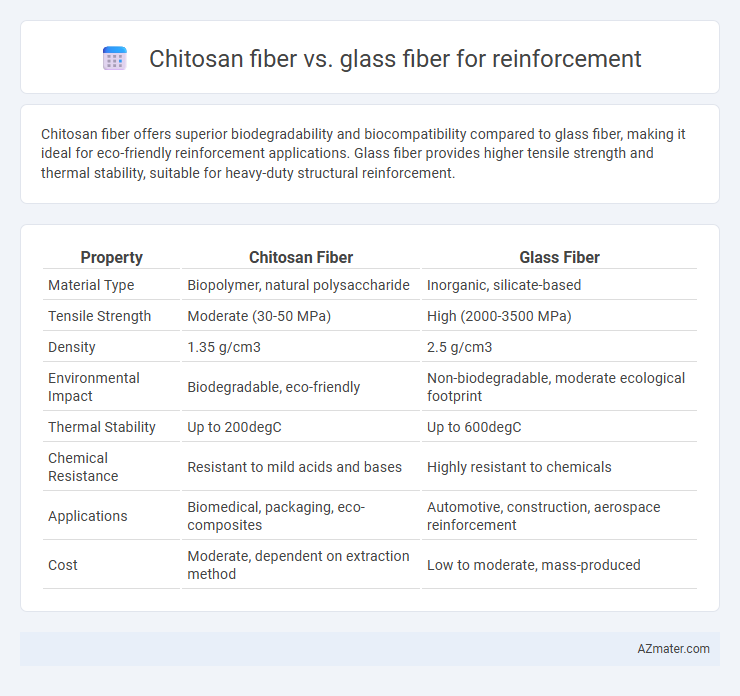Chitosan fiber offers superior biodegradability and biocompatibility compared to glass fiber, making it ideal for eco-friendly reinforcement applications. Glass fiber provides higher tensile strength and thermal stability, suitable for heavy-duty structural reinforcement.
Table of Comparison
| Property | Chitosan Fiber | Glass Fiber |
|---|---|---|
| Material Type | Biopolymer, natural polysaccharide | Inorganic, silicate-based |
| Tensile Strength | Moderate (30-50 MPa) | High (2000-3500 MPa) |
| Density | 1.35 g/cm3 | 2.5 g/cm3 |
| Environmental Impact | Biodegradable, eco-friendly | Non-biodegradable, moderate ecological footprint |
| Thermal Stability | Up to 200degC | Up to 600degC |
| Chemical Resistance | Resistant to mild acids and bases | Highly resistant to chemicals |
| Applications | Biomedical, packaging, eco-composites | Automotive, construction, aerospace reinforcement |
| Cost | Moderate, dependent on extraction method | Low to moderate, mass-produced |
Introduction to Fiber Reinforcement in Composites
Chitosan fiber and glass fiber are both used as reinforcement materials in composite manufacturing, offering unique mechanical and environmental properties. Glass fiber provides high tensile strength and durability, making it ideal for structural applications, while chitosan fiber offers biodegradability and excellent biocompatibility, suitable for eco-friendly and biomedical composites. Fiber reinforcement improves composite materials by enhancing load-bearing capacity, stiffness, and resistance to impact and fatigue.
Overview of Chitosan Fiber: Source and Properties
Chitosan fiber, derived from the deacetylation of chitin found in crustacean shells, offers biodegradability and biocompatibility that glass fiber lacks. Its natural polymeric structure provides excellent tensile strength and flexibility, making it a sustainable alternative for reinforcement applications. Chitosan fiber's moisture absorbency and antimicrobial properties further enhance its performance in composite materials compared to traditional glass fiber.
Glass Fiber: Composition and Key Characteristics
Glass fiber, primarily composed of silica (SiO2), alumina (Al2O3), and calcium oxide (CaO), offers excellent tensile strength, lightweight properties, and high resistance to heat and corrosion. Its amorphous structure provides superior dimensional stability and electrical insulation, making it ideal for composite reinforcement in automotive, aerospace, and construction industries. Compared to chitosan fiber, glass fiber delivers enhanced durability and mechanical performance, particularly in demanding structural applications.
Mechanical Strength Comparison: Chitosan vs Glass Fiber
Chitosan fiber exhibits notable mechanical strength with high tensile strength and flexibility, making it suitable for lightweight reinforcement applications. Glass fiber demonstrates superior stiffness and higher tensile modulus, offering enhanced load-bearing capacity and durability in structural composites. While glass fiber provides greater mechanical strength overall, chitosan fiber's biodegradability and good strength-to-weight ratio create advantages in eco-friendly and specialized reinforcement uses.
Biodegradability and Environmental Impact
Chitosan fiber offers superior biodegradability compared to glass fiber, breaking down naturally without leaving toxic residues, which significantly reduces environmental impact. Glass fiber, while strong and durable, poses disposal challenges due to its non-biodegradable nature and potential to accumulate as microplastics in ecosystems. The sustainable lifecycle of chitosan fiber makes it a preferred choice for green reinforcement applications aiming to minimize ecological footprint.
Compatibility with Matrix Materials
Chitosan fiber exhibits excellent compatibility with biodegradable polymer matrices such as polylactic acid (PLA) and polyhydroxyalkanoates (PHA) due to its natural hydrophilicity and abundant amino groups that promote strong interfacial bonding. Glass fiber, being inorganic and hydrophobic, often requires surface treatments like silane coupling agents to improve adhesion with polymer matrices such as epoxy, polyester, or vinyl ester resins. The superior chemical affinity of chitosan fibers with biopolymer matrices enhances mechanical properties and biodegradability, whereas glass fibers provide higher tensile strength but may suffer from poor matrix adhesion without proper surface modification.
Applications in Industrial and Biomedical Fields
Chitosan fiber offers superior biocompatibility and biodegradability, making it ideal for biomedical applications such as wound dressings, tissue engineering scaffolds, and drug delivery systems, whereas glass fiber excels in industrial reinforcement due to its high tensile strength, thermal resistance, and durability in composite materials used in automotive, aerospace, and construction sectors. Industrial applications benefit from glass fiber's ability to improve structural integrity and corrosion resistance, while biomedical fields prioritize chitosan fiber's antibacterial properties and compatibility with human tissue. The choice between chitosan and glass fibers depends on the required balance between mechanical performance and biological safety in specific reinforcement applications.
Cost Analysis: Production and Processing
Chitosan fiber offers a cost-effective alternative to glass fiber in reinforcement applications due to lower raw material expenses and biodegradable sourcing from crustacean shells. Production of chitosan fibers typically incurs reduced energy consumption and simpler chemical processing compared to the high-temperature melting and extrusion processes required for glass fiber manufacturing. Processing costs favor chitosan fibers as their lightweight, flexible nature reduces handling difficulties and tooling wear, further minimizing overall reinforcement material expenses.
Challenges and Limitations of Each Fiber
Chitosan fiber faces challenges such as lower mechanical strength and limited thermal stability compared to glass fiber, restricting its use in high-stress reinforcement applications. Glass fiber, while exhibiting excellent tensile strength and durability, suffers from brittleness and susceptibility to corrosion in harsh environments. Both fibers require careful consideration of compatibility with the matrix material to optimize bonding and overall composite performance.
Future Trends and Research Directions
Chitosan fiber demonstrates promising biodegradability and biocompatibility compared to traditional glass fiber, making it a sustainable alternative for composite reinforcement in industries focused on environmental impact reduction. Current research trends are exploring enhancing the mechanical strength and moisture resistance of chitosan fibers through chemical modification and nano-reinforcement techniques, aiming to match or surpass the durability of glass fibers. Future directions emphasize the integration of chitosan fibers in smart composite materials with self-healing and antimicrobial properties, driven by growing interest in eco-friendly and multifunctional reinforcement solutions.

Infographic: Chitosan fiber vs Glass fiber for Reinforcement
 azmater.com
azmater.com